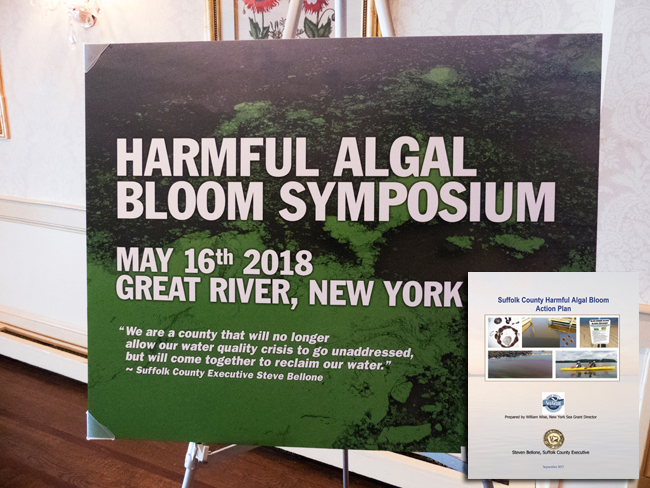NYSG assistance enhances Suffolk County Harmful Algal Bloom Strategic Planning
Contact:
Antoinette Clemetson, NYSG Marine Fisheries Specialist, P: 631-632-8730, E: aoc5@cornell.edu
Stony Brook, NY, March 4, 2019 - Incidents of harmful algal bloom (HAB) events continue to increase in occurrence and severity in waters around Long Island. This disruption results in significant economic loss to the fishing and outdoor recreation sectors when shellfish beds are closed for harvesting and swimming restrictions are imposed on beaches.
New York Sea Grant (NYSG) and the Suffolk County Department of Health Services facilitated a preliminary public consultation in 2016 to gauge the severity of the HAB problem on Long Island. This consultation resulted in a year-long discussion between HAB researchers and managers to achieve consensus about likely sources and actions necessary for nitrogen mitigation.
Under this partnership, a Suffolk County Harmful Algal Bloom Action Plan was published and formally released at a public meeting in 2018.
NYSG co-chaired the meeting planning committee with membership from Suffolk County government, the New York State Department of Environmental Conservation (DEC) marine and freshwater departments and three estuary programs. By way of this coordination, NYSG helped to fulfill the recommendation to reestablish HAB meetings on Long Island.
The 2018 Harmful Algal Bloom Symposium attracted more than 100 individuals involved with research, government agencies that coordinate HAB response, NGOs, and the general public. Participants learned about the process leading to the development of the Suffolk County Harmful Algal Bloom Action Plan, and mitigation strategies being implemented by Suffolk County government and the DEC to improve water quality.
NYSG also facilitated the first meeting of the Suffolk County HAB Technical Workgroup to review HAB monitoring to improve these actions. This secondary commitment by NYSG helped to advance another recommendation that was identified in the Suffolk County Harmful Algal Bloom Action Plan.

More than 100 people participated in the 2018 Harmful Algal Bloom Symposium to learn about actions being conducted in Suffolk County to mitigate nitrogen impact on water quality. Credit: NYSG/Ryan Strother; Inset: NYSG assistance enhances Suffolk County Harmful Algal Bloom Strategic Planning.
Partners:
• Suffolk County Department of Health Services
• New York State Department of Environmental Conservation
This project is partially funded by the NOAA Ecology and Oceanography of Harmful Algal Blooms (ECOHAB) Program Award # NA17NOS4780201 to facilitate harmful algal bloom information dissemination. The statements, findings, conclusions, and recommendations on this webpage do not necessarily reflect the views of New York Sea Grant or ECOHAB.
More Info: New York Sea Grant
New York Sea Grant (NYSG), a cooperative program of Cornell University
and the State University of New York (SUNY), is one of 33 university-based
programs under the National Oceanic and Atmospheric Administration’s
National Sea Grant College Program.
Since 1971, NYSG has represented a statewide network of integrated
research, education and extension services promoting coastal community
economic vitality, environmental sustainability and citizen awareness
and understanding about the State’s marine and Great Lakes resources.
Through NYSG’s efforts, the combined talents of university scientists
and extension specialists help develop and transfer science-based
information to many coastal user groups—businesses and industries,
federal, state and local government decision-makers and agency managers,
educators, the media and the interested public.
The program maintains Great Lakes offices at Cornell University, SUNY
Buffalo, SUNY Oswego and the Wayne County Cooperative Extension office
in Newark. In the State's marine waters, NYSG has offices at Stony Brook
University in Long Island, Brooklyn College and Cornell Cooperative
Extension in NYC and Kingston in the Hudson Valley.
For updates on Sea Grant activities: www.nyseagrant.org has RSS, Facebook, Twitter, and YouTube links. NYSG offers a free e-list sign up via www.nyseagrant.org/nycoastlines for its flagship publication, NY Coastlines/Currents, which is published quarterly. Our program also produces an occasional e-newsletter,"NOAA Sea Grant's Social Media Review," via its blog, www.nyseagrant.org/blog.